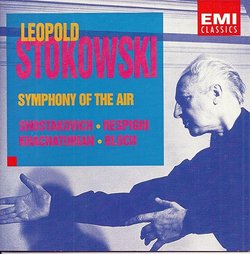| All Artists: cello George Neikrug, Ernest Bloch, Antonio Cesti, Girolamo Frescobaldi, Giovanni Gabrieli, Aram Khachaturian, Giovanni Pierluigi da Palestrina, Ottorino Respighi, Dmitry Shostakovich, Leopold Stokowski Title: Stokowski & The Symphony of the Air: Shostakovich, Respighi, Khachaturian, Bloch, Frescobaldi, Palestrina, Gabrieli, & Cesti Members Wishing: 0 Total Copies: 0 Label: Capitol Release Date: 11/15/1994 Genres: Special Interest, Classical Styles: Opera & Classical Vocal, Chamber Music, Forms & Genres, Concertos, Theatrical, Incidental & Program Music, Historical Periods, Baroque (c.1600-1750), Modern, 20th, & 21st Century, Instruments, Strings, Symphonies Number of Discs: 2 SwapaCD Credits: 2 UPC: 724356542723 |
Search - cello George Neikrug, Ernest Bloch, Antonio Cesti :: Stokowski & The Symphony of the Air: Shostakovich, Respighi, Khachaturian, Bloch, Frescobaldi, Palestrina, Gabrieli, & Cesti
CD DetailsSimilarly Requested CDs
|
CD ReviewsAn indispensable purchase for the Stokowski admirer Discophage | France | 02/01/2007 (5 out of 5 stars) "Let me join the two previous commentators and add on to their praise of this set, while also providing some additional information. It is an indispensable purchase for the Stokowski admirer. The two well-filled discs collect the contents of three and a half LPs recorded in 1958-9 and released by the apparently short-lived United Artists label: UAS 8001 had Respighi's Pines (surprisingly the Maestro's only studio recording of any Respighi, though a live Philadelphia concert of a year later had been available at one point on LP) and the transcriptions, UAS 8002 Khachaturian's sprawling second symphony, UAS 8004 the Shostakovitch compositions and UAS 8005 Bloch's Schelomo. Left out in the process are Paul Ben Haim's "From Israël" which served as a filler to Bloch and Beethoven's 7th symphony (Stokowski's second recording) which came on UAS 8003. The Symphony of the Air Orchestra is in fact the name assumed by Toscanini's reformed NBC Orchestra after it was disbanded by RCA, following the conductor's death. As remastered, the sound is saturated in some of the louder passages, especially in Khachaturian's symphony and there is some tape hiss, but one can only agree with the note of warning contained in the booklet: "these analog recordings were chosen for re-release on Compact Disc because of their artistic and historical significance. Unfortunately, the original master tapes suffer from a degree of distortion and irregularity which could not be eliminated in the re-mastering process. However, the importance of making available these definitive recordings should outweigh any such technical shortcomings". Khachaturian's 2nd symphony is a composition of vast and at times sprawling dimensions. Written in 1943, it is conceived as "a requiem of protest against war and violence" and has the bombast of Shostakovich's 7th and 8th symphonies, but also genuine dramatic sweep, in particular in its third movement, a funeral march starting with a melody of almost Spanish tinge - it could be music for Llorca's dirge for the fallen bull fighter - and soon mixed with the tune of the Dies Irae. I find it evocative of Shostakovich' 11th symphony. As mentioned, the sound is saturated in the louder passages and no match to the composer's own 1962 recording with the Vienna Philarmonic (Decca), but Stokowski, in his only recording of that piece (he also did the 3rd symphony and the "Masquerade"-Suite), conducts with plenty of color and panache. The same holds true of Shostakovich's brash first symphony, his second recording (the first was with Philadelphia in 1933, now on Pearl). His transcription of the composer's piano prelude Op. 34/14, here in the third of the Maestro's four studio recordings (there are also three live ones), makes it into a sombre, brooding and dramatic sister movement of the 11th symphony. Stokowski had done the first recording ever of Bloch's Schelomo, in 1940, with Emanuel Feuermann (available on CD from various labels). A pupil of Feuerman and of the apparently exceptional pedagogue Demetrious Dounis, George Neikrug doesn't belong to the stellar names of the cello who have recorded the piece (which, besides Feuermann, include, in rough chronological order, Piatigorsky, Rose, Fournier, Starker, Rostropovich, Harrell, Ma), yet he is second to none. He performs with big tone and romantic fervor, and the orchestra under Stokowski plays with fire, a few uncertain entries and sometimes almost overbearing presence, some of the solo wind interventions sounding forte rather than the indicated piano. One can find on the web a fascinating interview of Neikrug, in which he remembers being with Feuermann in California, twenty years before, when the latter received the first pressings of his recording with Stokowski; he also hilariously recounts the circumstances of the 1959 rehearsals, how they began in chaos and how suddenly and unexpectedly everything coalesced into the genuine and unique "Stokowski sound". The Stokowski transcriptions of pieces by four Italian Renaissance composers make them into full-blooded romantic pieces, evoking, especially in Cesti and Palestrina, Barber's adagio or even Albinoni's spurious adagio as it was customarily performed in the fifties and sixties. The effect is somewhat staid, but still deeply moving. The 17 page (including photos) liner notes are an integral part of this set's value. They contain lengthy comments of each composition (including the transcriptions) by William C. Baxter (who seems to confuse this recording of Schelomo and Stokowski's earlier one with Feuermann) and a biography of Stokowski by Kay Baumgartner (with an account of the circumstances of the recordings at hand) whose value comes from the fact that it is not a mere one-sided panegyric. " Very Rare Stokowski Jerome R. Selmer | Arcadia, CA, USA | 01/05/2006 (4 out of 5 stars) "These recordings are truly rarities. The originals were made for the now defunct United Artists label. Some years ago the master tapes were purchased by Angel Records (USA) and languished in their vaults for many years. With pressure exerted by individuals and the Leopold Stokowski Society of America, this set was finally released. Many of these pieces were never recorded by the Maestro at any other time. In my opinion, the gem in the set is the Shostakovich Symphony # 1. At the time of its original release it was hailed as the best recorded performance ever of this piece. I have never found another I like better. It is superb. Stokowski also brings out the very best in all the other numbers as well. It is an outstanding testament to the man and to a great orchestra. These recordings may never be released again. Get this set now while you can." A rare find, get this while you still can! vmzfla | Orlando, Fl. | 06/13/2005 (4 out of 5 stars) "This generous 2 disc set(over 70min. each)is comprised of recordings made for the defunct United Artists Record Label from
1958-59. I presume these are some of the last recordings made by The Symphony of the Air(formerly Toscanini's NBC Symphony). EMI has nicely remastered(only the bass lacking)the sound. We are given a somewhat average "Pines" and a congested but cinematic Khachaturian Sym. #2 on disc 1. Stokowski's period piece orchestrations/transcriptions emphasis modern choirs of brass. On disc 2, He affectionately conducts Shostakovich's youthful Sym. #1. We are given a robust account of Bloch's "Schelomo" with the renowned George Neikrug as cello soloist.(I think overall sound quality is better on this second disc.) This set is a must for any collector of Stokowski interpretations and what a value for those wanting a varied orchestral program. The selections are excellently annotated and their are some rare photos along with a informative essay about the great meastro. At time of my review this may allready be out of print, so hurry! " |


